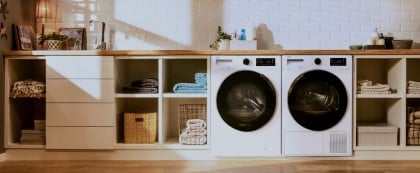How easy is it to install my washing machine?
Installing a washing machine is straightforward as long as you have the right instructions in front of you. To help make installation easier, we’ve created a comprehensive guide, complete with easy-to-follow videos so you can install your new washing machine yourself.
Plumbing a washing machine - what's needed?
Water supply line connection
When your washing machine arrives, it is important to check that you have the right accessories for easy plumbing. Ensure that all connections are secure and that the water supply is properly turned on before you start using your machine. Additionally, inspect the area around the washing machine for any potential issues, such as insufficient space or obstructions, that could impact its operation.
Drainpipe hookup
Your drainpipe should also be included and should be easily attachable to your washing machine. It is easy to identify as it will usually have a U-shaped sleeve. Again, it is important that you inspect the entire pipe to ensure there aren't any unnatural bends, kinks, or damage to the pipe. You should also check for any blockages before attaching and starting your machine.
Once your waste pipe is attached to your machine thoroughly, hand the pipe in a standpipe for easy wastewater removal.
How to install a washing machine step-by-step
Installing your washing machine can either be done by a professional or yourself. It can be an easy setup, especially if you're guided by the instructions in your manual. From preparing the washing machine area to attaching it correctly, there are a couple of steps you will want to follow to make sure you've got your washing machine set up and working correctly.
Here's a step-by-step guide to unpacking and installing your new Beko washing machine for the first time.
Please note, washing machines can be heavy, so be careful when lifting and moving. We strongly recommend you have someone assist you when lifting, tilting, and moving your washing machine.
Preparing the area
Before installing your washing machine, you'll want to make sure that your area is clean and dry. Make sure you've removed your old washing machine and all the fittings before unpacking your new washing machine. Removing the old fittings and using the new ones supplied can help prevent leaking or using the wrong size connectors.
Unpacking your new Beko washing machine
Your new Beko washing machine will arrive wrapped in plastic and protected with styrofoam.
Follow these simple steps to remove all packaging so that your new washing machine can be installed:
- Locate the plastic ribbon around the washing machine and pull to easily remove the protective wrapping.
- Remove the pieces of styrofoam from the top and sides of the washing machine.
- Locate the ribbon at the bottom of the washing machine, this will usually be attached to a sticker.
- Carefully tilt the washing machine back and pull the ribbon to release the piece of styrofoam from underneath the washing machine, then carefully replace the washing machine to its standing position.
Remove the transit bolts from your new Beko washing machine
When your new Beko washing machine is delivered, it will have up to five transit bolts attached to the back of the machine, which keep it secure while it is in transit.
These must be removed before you install your new washing machine.
The bolts are simple to remove and replace with the plastic caps provided. Just follow these steps:
- Using an appropriate tool, loosen the bolt until you can remove the bolt and the plastic covering from the washing machine.
- We suggest you store the transit bolts you remove in a safe place along with your product manual in case your washing machine needs to be transported again in the future.
- Locate the plastic caps which will have been delivered with your washing machine
- Insert each of the plastic caps into the holes left by the removed transit bolts.
Levelling and securing the washer
Your washing machine should be level to prevent excess noise and vibrations, and to ensure it has the right stability for its cycles and spin runs. Make sure that the surface you’re using is level. Your Beko washing machine needs to be completely level and must be on appropriate flooring, never carpet.
You can lengthen or shorten the feet of your washing machine by screwing or unscrewing each as needed. Make sure your washing machine sits flat and doesn’t move when you put weight on any of the corners.
To adjust the feet of your Beko washing machine, you should:
- Carefully tilt your washing machine back to reveal the adjustable feet. Please note washing machines are heavy, be careful when lifting and moving. We strongly recommend you have someone assist you when lifting, tilting, and moving your washing machine.
- Adjust the feet by hand. (Anti-clockwise to reduce height, clockwise to increase height)
- Check that the washing machine is now level again with a spirit level or by gently rocking it to see if it still moves.
- When the feet are in the correct position, and your washing machine is stable, tighten the lock nuts above each of the feet by hand. (Anti-clockwise)
Connecting the hot/cold water
Connecting the water correctly is important for the functioning of your washing machine. If you’re uncertain about connecting these correctly, get help from a friend or a professional.
Your main water inlet hose is located at the back of your washing machine. It has a right-hand connector at one end and a straight connector at the other. The right-hand connector should be attached to your washing machine, while the straight connector should connect with your taps. You should be able to easily tighten both by hand. Make sure both are fastened correctly to prevent leaking.
Check your water pressure
It’s a good idea to check the water pressure in your home is suitable for your new Beko washing machine before you install it.
Low water pressure can lead to your washing machine not working properly.
Follow these simple steps to check the flow of water:
- Turn on the cold tap situated nearest to where your Beko washing machine is installed.
- Measure the water flow rate. At least one litre in seven seconds is required.
- If the flow rate is less, you need a plumber to check your water line.
Attaching the drain hose to plumbing
Connecting your hose to the mains supply is important for the proper drainage of your washing machine. Improper installation can cause your washing machine to have difficulties draining or even siphoning water. Your drainpipe will come attached to your washing machine; all you need to do is connect it to your sink drainage or standpipe. Ensuring all pipes and drainage points are free from debris and blockages can help your washing machine run smoothly.
Connecting your new washing machine to the mains power
Follow these simple steps to connect your washing machine to the mains power:
- Do not plug your washing machine into an extension socket, only ever plug your washing machine into a mains wall socket.
- Test that the power socket is working by plugging in something you know is working, a light for example.
- Once you have ensured the socket is operational, you can plug your washing machine in.
- If your washing machine does not turn on when connected to the power, there may be an electrical fault.
How to fit a washing machine yourself
Attaching your washing machine yourself can be an easy task. Some steps to take to install a washing machine yourself include:
- Removing the old washing machine, including all pipes and fittings.
- Unwrapping your new washing machine.
- Removing transit bolts.
- Attaching water tap with the straight attachment.
- Attaching waste pipe to sewage supply.
- Plug in your washing machine to your mains.
- And you’re ready to go.
Is DIY installation advisable?
DIY installation doesn't have to be difficult. In fact, most washing machines are designed for simple installation. You should be able to connect it to your water supply, standpipe, and electrical mains with ease. If you're struggling to do so yourself, having a friend help can be useful - especially if you need help pushing your washing machine into the right space.
When to hire a professional?
You should hire a professional if you need extra pipework fittings or electrical sockets. This might happen if you're moving your washing machine to a new location in your home or if you're unsure how to connect it. You can always hire a professional if you're uncertain about how to connect your washing machine.
You should also hire a professional if you find your washing machine is affecting your plumbing when it is running.
Washing machine installation tips
Installing a washing machine should be easy, but there are a couple of tips and tricks that can make the experience even easier. Whether you’re moving house with your appliance, or you’ve bought a new one for your home, making sure it is installed correctly and easily can give you the best, fresh laundry in minutes.
Allow proper space
One of the key parts to consider when installing or moving a washing machine is the space you have. Not only should your washing machine dimensions fit in the space that you have, but having additional space around can make installing and connecting your washing machine a bit easier.
Having the right tools
Most washing machines can be installed and moved simply by hand. Your waste and water pipes should be easily moveable by hand. However, if your machine is a bit older or you’ve not moved these for a while, you might need some tools to help you move them. Depending on your at-home plumbing, you might need different connectors for your water or waste pipes, so make sure you’ve got these before trying to install them.
Testing for leaks
There are a couple of ways you can test your washing machine for leaks. You might find excess water straight after a cycle, which could indicate a leak, but you can also test it. Checking your pipes for blockages and tears before installing can help prevent leaking. If you notice something wrong with your pipe before installation, contact your manufacturer.
You can test your pipes by pouring water through them before connecting them to your washing machine. Another method is to wrap tissue around both hoses and run a short cycle. If any of the tissue is damp, it might be an indicator that there is a leak.
Common washing machine installation issues
Installing your washing machine can sometimes come with issues, especially if everything is not attached properly. If you're finding that your washing machine isn't running as you expected, or your appliance is leaking, you might need to troubleshoot what is going wrong.
Some common problems include:
Leaks and poor drainage
Leaking and poor drainage are two issues that you can find with your washing machine. Whether it is due to poor installation, or something is broken, finding the cause of the problem and fixing it is important for the cleanest clothing. Try our tips for figuring out if your pipes are causing your leak.
Excessive vibration
Excessive vibration isn’t only worrying for some, but the noise can become distracting. If you’re finding your machine is vibrating excessively during its cycle, then there might be a couple of problems.
One issue might be the laundry load. If your laundry is unbalanced, it might cause your washing machine to move excessively during high spins. Balancing your load is essential for the best wash. Other issues might include an uneven surface making your washing machine unstable—make sure to adjust your legs to the necessary lengths to make your appliance level.
If you’re experiencing excess noise, see here.
Electrical issues
If you’re experiencing electrical issues with your washing machine, you could be tripping the electrics. This can be caused by multiple things, including water leaking onto the electrics or your washing machine motor tripping your fuse box. It is important to seek professional advice if you’re experiencing this.
Water supply problems
Water supply problems can have multiple causes. They might be due to internal plumbing, poor water pressure, a blockage or damaged pipe, or other issues. Finding the cause of the problem can help you identify what needs fixing. If you’re experiencing water supply problems regularly, it might be worth hiring a professional to take a look.
Be sure to consult your appliance manual, and if you do get stuck, don’t be afraid to consult a professional or call our customer care team. Please find our contact details by clicking here.
Did you find this How-To guide useful?
Thank you for your feedback and we are sorry this How-To Guide wasn’t useful to you. If you would like further assistance, please head over to our Contact Us page.
Need Product Support?
If you have any questions about your Beko appliance, we are here to help. Finding answers and information is easy with Beko’s helpful online resources, simply browse our product support topics below and select the one that is relevant to you.
Manuals
Beko manuals contain helpful information and advice about your appliance.
View ManualsParts & Accessories
We stock genuine Beko spare parts and accessories for all of our models.
View Range NowFAQs
Browse the most asked questions about our product range.
Search FAQsRepairs
Information on our professional repair services.
View Repairs











